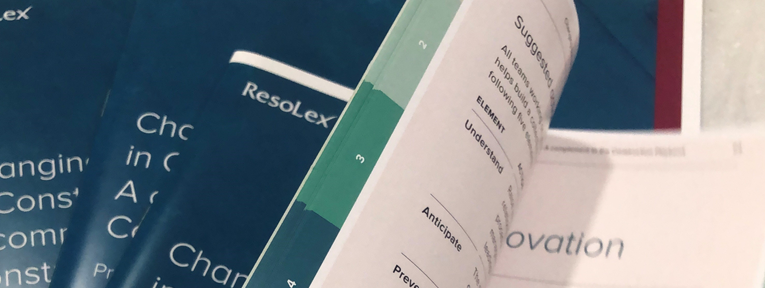
Jul 12, 2022 | Events, Roundtables
Putting The Construction Playbook into Practice – 30th June 2022
Facilitated by Ed Moore and Kelachi Amadi-Echendu
ResoLex’s Roundtable series recommenced with our first in-person session since Autumn 2019 and in our new home – you may have seen, we have relocated along with our friends from the International Dispute Resolution Centre to Paternoster Lane right next to the beautiful St. Paul’s Cathedral – where we welcomed a select group to delve into some of the key aspects of The Construction Playbook.
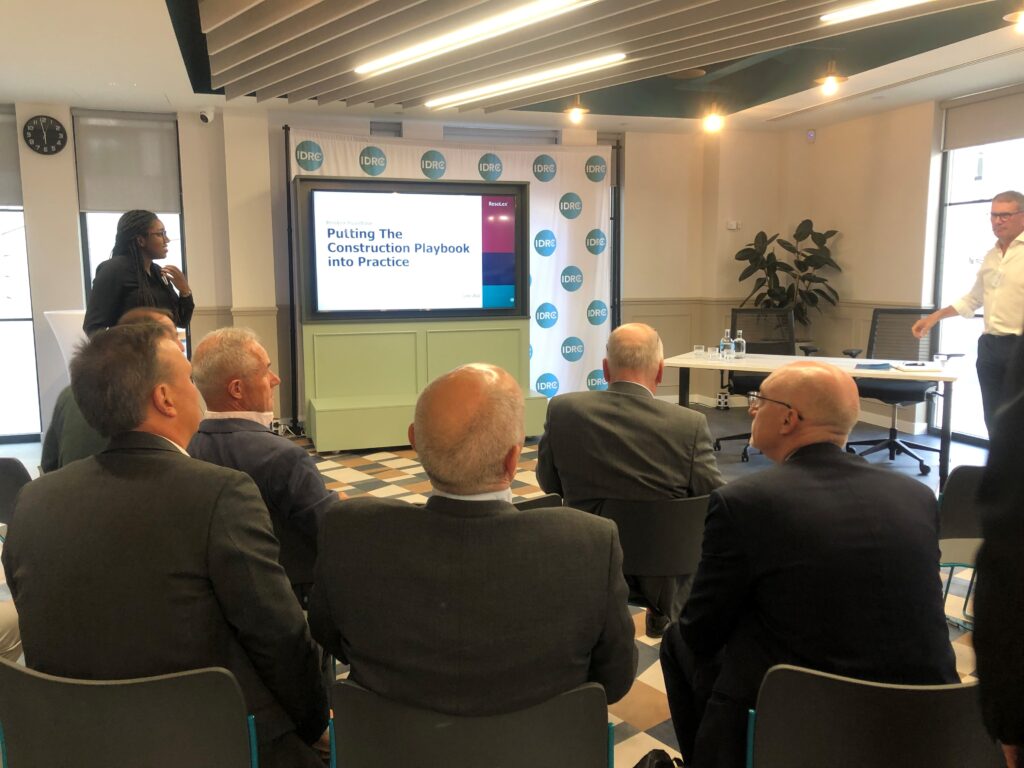
Our Chief Exec, Ed opened the session by setting out our view that the success of major projects hinges on three critical interlinked elements; Technical, Commercial and Social. His observation is that The Construction Playbook continues the worthy objective of modernising the construction industry. However, reading through the document one can see that its focus is primarily on a project’s technical and commercial elements, but has little to say on the social element, on the people that deliver projects.
Our Senior Consultant, Kelachi then introduced the report we recently produced, Changing Behaviours in Construction: A complement to The Construction Playbook. The report brings together our experience and contributions from our Associates and is designed to act as a complement to The Construction Playbook. It provides practical guidance on the behavioural and cultural elements that supplement some of the key recommendations in the Playbook, focusing on actions and activities that we know through our experience help to build a project’s ‘social capital’.
Our Roundtable sessions are designed to be an interactive discussions rather than a lecture. We, therefore, had an interactive session with participation from everyone in the room, offering a range of perspectives around two key topics:
- Collaborative Leadership
Leadership has been a hot topic within the industry lately. Kelachi pointed out that it is discussed throughout our report and was recently raised in the second iteration of the ICE review: A Systems Approach to Infrastructure Delivery. An article in the NCE references the report as identifying the need for projects to move on from the habit of appointing ‘hero leaders’ – you can find the full article here.
There was consensus in the room that when faced with complexity, there is a need to adopt different leadership styles and attributes and, that collaborative leadership is desirable, but it is probably more important to embed the right culture at the start. The discussion also brought out the recognition that the leadership needs of a project change as the project/programme moves through the cycle. In modern construction, leaders need to be truly agile, and able to adjust their approach depending on circumstances.
- Front End Loading
Ed picked up on the requirement in the Playbook to put more time into the start of a project to think through how a team will work together before moving into the task of construction. The question to the room was the extent to which this would add value.
The consensus was that time spent working through potential issues with the full design and delivery team, ideally producing a digital twin, would ultimately produce a better outcome. The proviso, however, was that project teams need to be clear on the main focus, as time can easily be frittered away on inconsequential matters.
The other challenge identified is that upfront investment in building relationships could be wasted if individuals involved in the early stages of a project then quickly moved on to other projects or roles. The answer to this problem was seen to be the need to proactively establish a strong culture so that new entrants to the project would quickly pick up the required mindset and behaviours set out in the beginning.
Summary
Taking an overview of the evening’s discussion, the common perspective was a recognition that the social, and therefore people component is a key element in the shifting of behaviours to enable the construction industry to deal with the complexity and uncertainty that are features of our current environment. The industry must therefore focus more effort to train leaders in how to become more agile and understand how to build project cultures that will embed collaborative ways of working that will endure through the life cycle of a project.
You can access The Construction Playbook and our report through the links below:
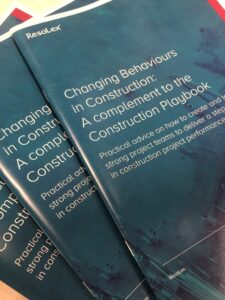
The Construction Playbook
Changing Behaviours in Construction: A complement to The Construction Playbook
Tony Llewellyn – 4 July 2022

Nov 29, 2021 | Events
It was great to be back in the room with leading construction industry professionals for Digital Construction Week 2021. Not only did we meet some great people, but we were also delighted to share our ‘Top Five Suggestions for Improving Project Performance through Collaborative Behaviours’ on the ‘People and Change Stage’.
The construction industry has come under criticism for low productivity over many years. Together with previous initiatives, the Construction Playbook speaks to some of the key challenges we need to overcome to get better, faster and greener delivery of projects. Current studies show that:
“…only 35% [of projects are] on or under budget and 32% on or ahead of schedule…” Deltex Clarity Industry Report/Riba Journey, Aug 21
‘The Construction Playbook’ requires all public bodies who commission construction projects to ‘comply’ or ’explain’ and has the intention to generate a step-change in project performance. The Playbook provides some clear approaches to what we need to do, though it doesn’t explain how to achieve behavioural change.
In our complimentary report, ‘Changing Behaviours in Construction: A complement to the Construction Playbook’, we have considered the cultural and behavioural changes needed to enable this transformation of the industry and explained some best practice tools that project leaders can use to improve performance.
There is a flawed assumption that project professionals should be able to behave logically and rationally and, that cooperation and collaboration should automatically happen irrespective of circumstances – known as The Collaboration Fallacy. After 20 years of experience working with major project teams, at ResoLex, we know how important it is to invest time in teams to develop the right behaviours and procedures to work collaboratively and in turn effectively.
Top Five Suggestions for Improving Project Performance through Collaborative Behaviours
1. Front-end loading
Front end loading is a project management concept where time is prioritised at the start to think through the project’s implications and its needs. If we resist the collective industry urge to press on and start quickly, there is the opportunity to influence behaviours at the beginning when team behavioural norms are still forming. This involves pulling key individuals into a series of discussions where the multiple problems that can generate complexity can be worked through. It requires an underlying mindset that doesn’t push every difficult issue down the road to be sorted out later.
Getting on board with the concept of front-end loading and allowing more time to think clearly and articulate how to achieve the desired outcomes, will result in a big payoff further downstream.
Our recommendation:
A great way to stimulate a high-level strategic conversation around a project’s needs is to use a version of our strategy canvas. The one we have developed has 8 key areas, each of which prompts a series of questions for discussion about the internal and external factors.
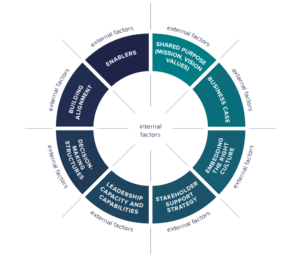
2. Selecting the right team leaders
When selecting both the leadership structure and the individuals who will take on senior roles in the team, focus not only on their technical experience but also on their ability to deal with the social complexity of delivering major projects.
There are three primary elements to every construction project:
- Technical – the knowledge and awareness of how the project components are designed and assembled.
- Commercial – the knowledge and awareness of issues around money, contracts and the identification and management of risk.
- Social – the knowledge and awareness of how we behave in groups and teams.
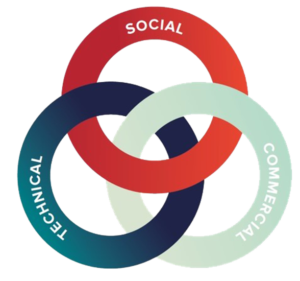
The key is that the three are intrinsically linked. High performance cannot be achieved if we are not doing enough to enhance and maintain the social competence of our teams – particularly those in leadership roles – alongside their technical and commercial development.
Our recommendation:
The step-change in performance comes when project leaders also develop and use the skills and capabilities associated with social intelligence, for instance:
- Understanding group dynamics
- Motivational drivers
- Systems thinking
- Balancing trust vs control
- Conflict resolution
- Team resilience
3. Measuring cultural development
The Construction Playbook suggests using a project scorecard and setting out various measurements in the form of KPI’s. The challenge is, how do we measure behaviours?
At ResoLex, we look at this in a couple of different ways. We measure behavioural risk and track early warning signals around 4 key areas using our proprietary tool, RADAR. This helps teams understand the short-term actions they can take to improve behaviours. We also measure cultural maturity using a matrix approach and help teams create long-term development plans to embed the desired culture.
Our recommendation:
Tool no.42 from our Collaboration Director, Tony Llewellyn’s Team Coaching Toolkit helps teams identify the behavioural indicators with a simple measurement methodology providing low and high scores.
4. Aligning to a common goal
Chapter four of the Playbook recognises the importance of creating alignment and clarity between the project team, primary decision maker and key stakeholders.
Our many years of research into team performance have helped us understand that group behaviour can be influenced if the team members bond through a range of exercises that are designed to tap into the emotional connections needed to grow trust.
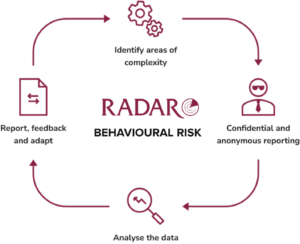
Our recommendation:
We recommend taking the time to get every team aligned to a common goal and a common project culture through a team setup process, including compulsory early workshops covering the seven core team development areas mentioned below:
- Articulate a clear vision
- Actionable values
- Build relationships
- Roles and accountabilities
- Rules of engagement
- Test assumptions
- Conflict management
5. Adjusting the mindset of conflict avoidance
Whilst conflict is fundamental to organisations, unfortunately, it is also something that we naturally want to avoid! But conflict is part of prioritising, planning, strategy, resource allocation, design and everything else in an organisation – or at least it should be. The ability of leaders to work through opposing sides of challenging emotional and political discussions and arrive at a resolution is in the best interests of the team, the client, the stakeholders and the shareholders.
In overcoming conflict, we need to adjust our mindset and think about the positive outcomes. First, acknowledge that conflict is productive and that your team may have a natural tendency to avoid it. We can base our new conflict mindset on the idea that there is more than one right, more than one version of the truth, more than one perspective. Underpin it with the belief that diversity of thought leads to better outcomes.
Our recommendation:
A ‘No Blame Culture’ is regularly set as the goal for teams coming together. Using something like this ‘No Blame Protocol’ can help give clear expectations to the team on how to approach a difficult situation.
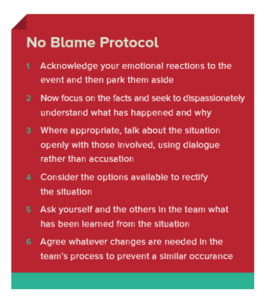
Through our five suggested best practices, we have highlighted some tools that you as leaders can use to improve your collaborative team performance.
We hope that these recommendations and tools will help you and your teams work better together to deliver projects more efficiently. If you would like further guidance, please contact us or sign up to join our Professional Learning Network, full of peer-to-peer roundtable events, resources and advice: https://resolex.com/resources/

Nov 16, 2021 | Events
Digital Construction Week is a two-day event bringing industry professionals together to explore innovation in the built environment. The exhibition is held at the Excel Centre, London on the 24th and 25th November 2021. If you’re looking to become more efficient, collaborative, connected, profitable, and sustainable – this is the place to be!
If you’re attending, you can join our very own Consultant, Kelachi Amadi-Echendu and our Associate, Karen Fugle (also, Executive Coach at SleepingGiant Consulting) in the ‘People & Change’ theatre at 4pm on the 25th of November. During the session, we’ll be diving into our top five suggestions for improving project performance through collaborative behaviours with reference to our latest publication ‘Changing Behaviours in Construction: A complement to the Construction Playbook’. You can find the full summary on the Digital Construction Week website here.
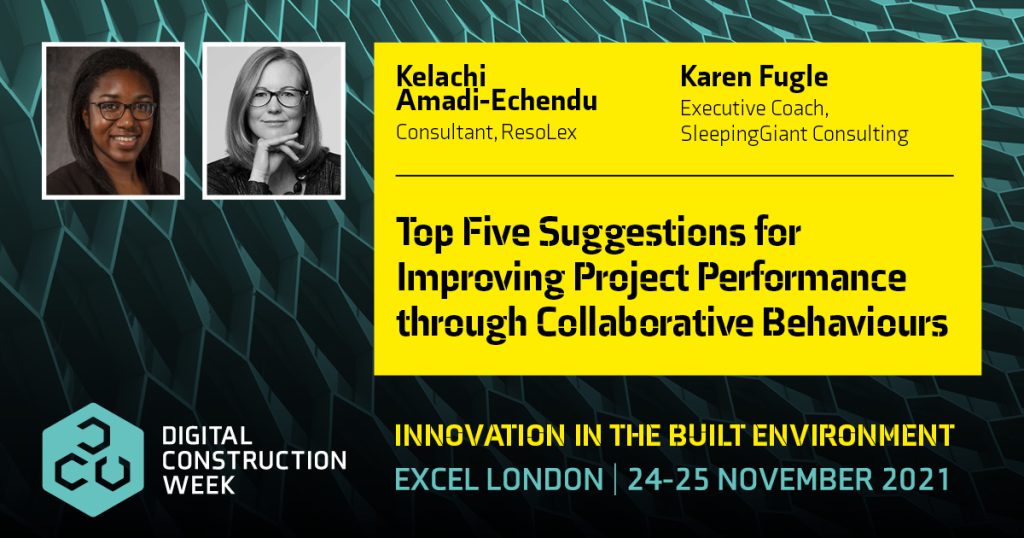
If you haven’t already, register here for your free delegate pass.

Jun 19, 2019 | Events, Roundtables
With Howard Britton
There are not many speakers who invite the audience at the very start of a presentation to regard him as obnoxious!
But Howard is not an ordinary presenter. With a wider and more varied career background than most, including a
period as a practicing Psychoanalyst, Howard is well qualified to provide a fresh perspective on the topic of diversity.
Howard invited us to join him on a journey of thought, which he divided into three parts.
PART ONE – TEAM ARCHETYPES
Howard suggested that there are four common character types that can be found in most teams.
TYPE 1 – THE ‘IDEAS’ PERSON This is an individual who is constantly thinking of new ways of doing things. People like this are typically regarded as mavericks.
TYPE 2 – THE ‘GRAVE DIGGER’ A person who seeks order and needs to sort everything into neat boxes.
TYPE 3 – THE ‘ENGINEER’ This is someone who loves process and believes in things being done in a particular and consistent sequence.
TYPE 4 – THE ‘DOER’ Someone who likes action and has limited patience with planning. She just wants to get things moving.
The inference as that the motivational drivers of everyone in a team will be influenced by factors that are little to do with
the work environment and are more likely to be shaped by their genetic wiring, as well as their childhood experiences.
Each will have a preference for the type of work they do.
The problem, however, is that most companies do not recognise these differences and often require people
to work in a way that is misaligned with their core drivers, leading to average or below-average performance. Howard then identified several leadership archetypes:
The ‘dense’ leader, who is highly egotistical, believes can do everyone’s job better than they can. This type of leader does not listen and therefore lacks real understanding of what is going on in his team.
The ‘empty’ leader, who has been overpromoted and is clueless as to how to do their job. Ideas and feedback from the team go into a void.
The invisible leader, who is rarely available to her staff, and whose focus is anywhere but on her team. She is continually travelling or in meetings.
The ’Socratic’ leader, who is clear that she doesn’t know everything. She is therefore continually listening to her team trying to understand them. This is the type of manager that is likely to get more productivity from members of her team.
Howard’s point is that in order to successfully manage the four archetypes within the team, leaders must work with their people at the level of their identity. He emphasised that individuals are unlikely to change and so the business must adapt to them to get the best out of them, although this is incredibly challenging.
PART TWO – HIGH PERFORMING TEAMS
Howard noted that in a volatile and uncertain world, many organisations are seeking a step change in how they
operate. This will require a change in organisational philosophy where leaders must identify their vision of a
future state and then work backwards to plan how to achieve it. He cited the example of Dale Evans at Anglian Water who declared a vision for a 50% reduction in carbon from the company’s capital expenditure programme. Dale did not
know how this target would be achieved but engaged the wider team in agreeing a series of steps that would lead to
the desired outcome. These steps forced the team to break out of their ‘business as usual’ mindset and imagine a
different future with a new working philosophy. With such challenges, tapping into the different archetypal drivers
present in the team improves the chances of breaking out of the “business as usual” mindset.
This leads us towards the challenge for leaders and managers to find out what each member of their team is really
good at and harnessing it. Howard suggested that his model of archetypes has some relational aspects, where one
type of person can handle knowledge or information to be passed onto the next type of person by the leadership. In
this way, the team all perform at their best and the best outcome is achieved.
PART THREE – COGNITIVE DIVERSITY
In the final section of his presentation, Howard focused on the distinction between the diversity
of technical skills and emotionally driven cognitive skills. His argument was that whilst a diverse range of technical skills can be taught, emotionally driven abilities are embedded, and cannot be easily learned. Recognising the different cognitive archet ypes is therefore an important element in the success of teams, particularly where the team is being asked to deliver innovation, or a step change from business as usual. Howard consequently separated diversity into three primary elements:
- SKILLS DIVERSITY – knowledge and experience
- IDENTITY DIVERSITY – who we are as a person
- COGNITIVE DIVERSITY – how we think
Howard noted that much of the recent discussion about diversity focuses on the need to include minority groups into
teams who may otherwise be excluded based on their gender, race, sexuality and so on. His view is that this
discussion is much needed to ensure equality of opportunity and that everyone in the workplace is treated with dignity
and respect, regardless of our diverse identities. Howard’s suggestion throughout the evening was that perhaps the second discussion is emerging to resolve the complex challenges today’s project teams face; one that considers
diversity not only from the perspective of our identity but also how to harness the diversity
of our thought to optimise teams and deliver high performance.
Tony Llewellyn, June 2019
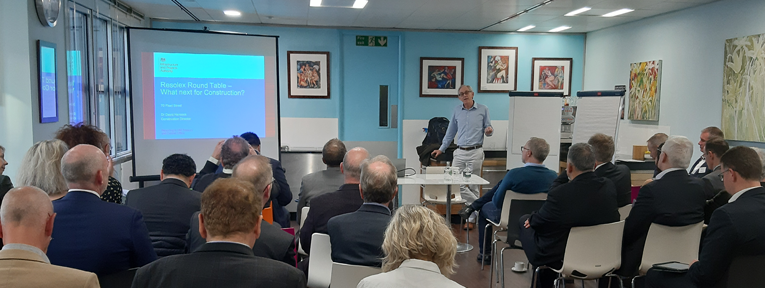
Mar 10, 2019 | Events, Roundtables
A short summary of the presentation by David Hancock, Chairman of the Government Construction Board for the Cabinet Office and the Infrastructure and Projects Authority and is also chair of the NEC UK Users’ Group. volume
David’s presentation led to a lengthy discussion and debate from many differing perspectives, considering challenges around risk allocation, industry-level collaboration and the impact of digital technologies on the future of construction and infrastructure delivery in the UK.
David opened the session by commenting that construction in the United Kingdom is currently at the centre of a perfect storm, which will drive change in at least some parts of the industry. Customer dissatisfaction, low (or no) contractors’ profit margins, and a shortage of skilled labour are all creating pressure to find alternative business models. Adding in the rapid digitalisation of many other aspects of the world economy offers a significant opportunity to those firms who are prepared to invest in different ways of working; a huge threat to those that are not.
As chairman of the Infrastructure and Projects Authority (IPA), David has an overview of a huge pipeline of expenditure. The Government is planning to put £600 billion into the country’s infrastructure over the next 10 years. As the biggest client in the country, they have the potential to be a huge influence on the industry. Recognising the importance of their role, the IPA have an ambitious vision to use digital information technology to improve how the public estate is designed, constructed, operated and integrated into the country’s built environment.
The Government is therefore involved in a range of initiatives, one of which is a presumption in favour of offsite construction. Five of the largest government departments have committed to a platform design strategy based around increased standardisation, with the intention that more building components are manufactured in a controlled environment. David acknowledges that offsite manufacturing for construction is complicated and will take time to develop. The future potential benefits, however, are immense, not only producing a better product but also offering the opportunity of significant savings in cost and time.
Construction Innovation Hub
The Construction Innovation Hub brings together world-class expertise from the Manufacturing Technology Centre (MTC}, Building Research Establishment (BRE) and the Centre for Digital Built Britain (CDBB) to transform the UK construction industry.The future potential benefits, however, are immense, not only producing a better product but also offering the opportunity of significant savings in cost and time. Government has chosen three partners to form the Construction Innovation Hub. Aligned with the themes of the IPA publication, Transforming Infrastructure Performance, this Hub is intended to be the centre of excellence, driving challenge and change into all aspects of infrastructure delivery to provide innovation and improved performance and productivity. There is a clear focus on improving the use of digital and advanced manufacturing technologies to provide the benefits required.
“Although there have been developments in BIM and increased uptake of digital technologies, in
construction we still use digital in an analogue way.”
One of the primary barriers the industry must overcome is the low levels of collaboration and connectivity. David provided a graphic illustration showing how weak the networking effect is within construction when compared to industries such as software engineering, manufacturing, financial services and media. The outcome of such low connectivity is the very slow spread of new ideas and limited innovation.
The IPA is also supporting initiatives such as Project 13, where value is based on overall outcome rather than simply looking at cost and programme. They recognise the challenge is to build more collaboration through the industry so that everyone can help make the ‘pie’ bigger rather than simply focusing on their own self-interest. The government has chosen three partners to form a Construction Innovation Hub. These are:
- Manufacturing Technology Centre The Manufacturing Technology Centre (MTC) develops and proves innovative manufacturing processes and technologies in an agile, low-risk environment, in partnership with industry, academia and other institutions.
- Building Research Establishment We are an innovative group of researchers, scientists, engineers and technicians who share a common goal – to make the built environment better for all. We generate new knowledge through independent research.
- Centre for Digital Britain The Centre for Digital Built Britain is a partnership between the Department of Business, Energy & Industrial Strategy and the University of Cambridge to deliver a smart digital economy for infrastructure and construction for the future and transform the UK construction industry’s approach to the way we plan, build, maintain and use our social and economic infrastructure.
The Construction Innovation Hub will support the four key themes around which the IPA is shaping its plans, explained in detail in their publication, Transforming Infrastructure performance.
David closed the session by asking the audience how these plans might have an impact on the day-to-day practices of our own work. For change to take place within the industry each of us should examine how digital transformation could have a positive impact in the way we choose to operate.
His underlying point is that the Government can act as a catalyst for change but finding answers to the challenges posed will require the engagement of individuals and organisations who are prepared to invest time in working through the complexity of the challenge to build for the future.
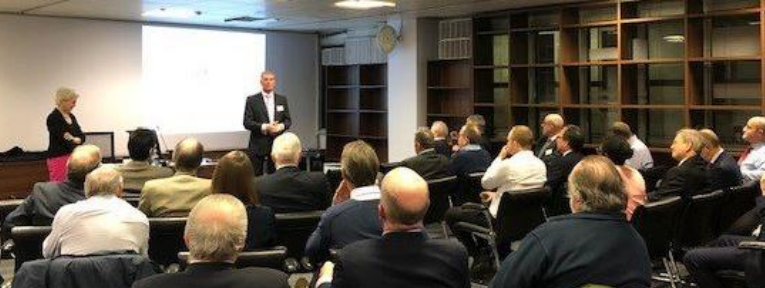
Jan 17, 2019 | Events, Roundtables
Roundtable with Jane Gunn
Jane is a Professional Speaker, Mediator, Facilitator, and One-To-One Coach at Gunn Consultancy. She is Chair of the Board of Management of Chartered Institute of Arbitrators, Past President at the Professional Speaking Association and Owner of Corporate Peacemakers.
Jane opened the session with the observation that many people would rather parachute out of an aeroplane for the first time or even get their head shaved, than address difficult conflict issues at work.
And, yet it is commonly acknowledged that
“whatever is unspoken is the hardest thing to change.”
The basic premise of Jane’s presentation is that organisations should adopt the habit of addressing conflict early, and to do this they need established a clear process.Managing the process is particularly important when collaborating with other teams or organisations, where miscommunication and misunderstanding can quickly descent into conflict.
A large part of the problem is that we ignore the warning signs of early conflict, but because it is an emotive issue, the growth of dissatisfaction is exponential and so when left too long can be explosive.
Jane illustrated the conflict sequence as a stepping process through a number of stages:
Stage 1
The parties stop talking
Stage 2
They talk to others, trying to build support for their case
Stage 3
They start issuing threats
Stage 4
They take action to coerce the
others to concede or be punished
Stage 5
Positions become entrenched as egos become fixated on not losing face
Stage 6
Into the ‘abyss’ together
Conflict management is crucially about identifying conflict early and taking action.
Our brains are wired to be on alert for threat, measuring what is happening in every conversation and non-conversation.
A model for conflict management
Jane drew up a model identifying some of the key aspects of conflict management. Creating a degree of consciousness about these factors will help reduce conflict and allow for faster intervention.
Consideration – Treating others with courtesy
Connection – Being made to feel part of the ‘in group’ or excluding others
Control – A common trigger for conflict is when we feel events are beyond our control Caring – Making others feel they are heard and are important
Culture – How are things done around here
Conditioning – What bad behaviours appear to be acceptable?
The service expected from our leaders has changed and conflict management should now therefore be an important role to build better solutions, without creating the destruction that happens when we enter the abyss.
When asked if there is a particular process that could be adopted, Jane’s view was that it would vary from organisation to organisation and even from team to team. Through the questions that came from the floor, however, some of the important ingredients for conflict management are as follows:
- Having emotionally intelligent people on the team makesa significant difference.
- ‘Fist bangers’ neededhelp to understandthat aggression rarely moved them forward.
- At the start of a conversation, agreeing how we will proceedis crucial.
- Deciding when to act. This is a judgement call,e.g.is this still going to be a problem in two weeks time?
- Encourage self-determination before escalation. Encourage people to sort their own issues rather ‘pass the monkey onto someone else’s back.’
- Where is conflict likely to occur and what preemptive actions can be put in place?
- Encourage the linguistic habits of dialogue over debate.
Jane packed a lot of very useful information into a short session, but the key message I took away from the event was forteam leaders to recognize their potential tendencies to ignore conflict and to take time early in the project cycle to agree a process that encourages healthy disagreement, andalso addresses interpersonal conflict shortly after it starts to emerge.
Tony Llewellyn, January 2019












